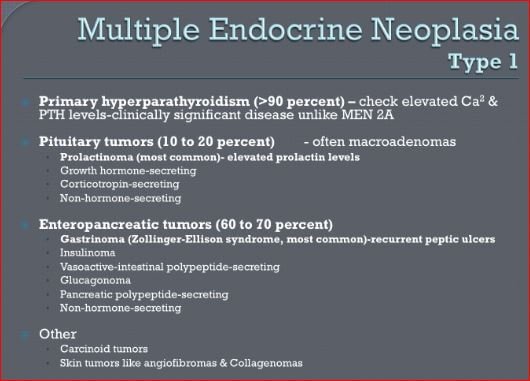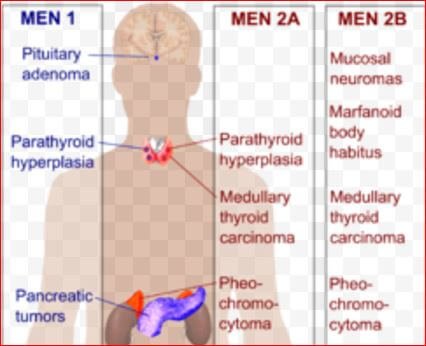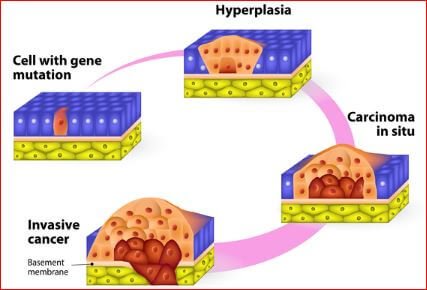What is Multiple Endocrine Neoplasia?
Multiple endocrine neoplasia is a collection of disorders affecting the endocrine system. Endocrine system comprises of glands that produce hormones that control your body functions such as metabolism, reproduction, growth and development, homeostasis, and others.
Multiple endocrine neoplasia is characterized by enlarged tissues (tumor) in several endocrine glands. These tumors may be benign (noncancerous) or cancerous and can cause the endocrine glands to become hyperactive and produce excess hormones in the bloodstream. 1, 4, 5

Endocrine System
There are many endocrine glands in your body that work together to regulate your bodily functions. These glands manufacture, store and release different hormones in your body. The glands use blood vessels to deliver hormones to different cells of your body. These glands include:
- Pancreas
- Ovaries
- Testes
- Thyroid
- Adrenal
- Thymus
- Pituitary gland
- Hypothalamus
In order for your body to function properly, the following must work as they are supposed to:
- The endocrine glands must balance the amount of hormone secreted
- The hormones should not be too little or excess.
- Your body should have a constant supply of blood
- Target cells or tissues should have enough receptors as well as respond properly to the hormonal signal.
If any of the above is not working properly, you may develop an endocrine disease.
Types
There are three types of multiple endocrine neoplasia:
- Multiple endocrine neoplasia 1 (Wermer’s syndrome)
- Multiple endocrine neoplasia 2A (Sipple syndrome)
- Multiple endocrine neoplasia 2B
Multiple endocrine neoplasia 1 (Wermer’s syndrome)
This disorder mostly affects your pituitary gland, pancreas and parathyroid gland. The tumor usually appears in your parathyroid gland first, but the tumor is noncancerous. Parathyroid glands are located in your neck area and are four in number; each side of your thyroid has two pairs of these glands.
Parathyroid glands manufacture parathyroid hormones, which control phosphorous and calcium levels in your body. Multiple endocrine neoplasia 1 causes your parathyroid gland to enlarge and become overactive, a condition also called hyperparathyroidism.
Hyperparathyroidism raises the parathyroid hormones levels, which increases the calcium levels in your blood. Increased calcium levels in the blood can make you develop kidney stones and have very weak bones.
Individuals with 40 years are more affected by hyperparathyroidism although this condition is present in teenage years.
Multiple endocrine neoplasia 1 occurs in your pancreas, which is situated behind your stomach. Pancreas produces insulin and gastrin hormones. Insulin hormones control the level of sugar in your blood while gastrin hormones are released into your stomach to assist in digestion.
There are three types of pancreatic tumors:
- Gastrinomas (produce gastrin)
- Glucagonomas (produce glucagon)
- Insulinomas (produce insulin).
Elevated levels of gastrinomas in your blood can cause Zollinger-Ellison syndrome; this is recurring ulcers of the upper gastrointestine. This condition affects about 50% of patients with multiple endocrine neoplasia 1.
Insulinomas tumor increase insulin hormone levels in your blood, which can lead to hypoglycemia (increase in blood sugar level) or decreased blood sugar. This lowers glucose levels in your blood, which cannot support body activities.
Glucagonomas tumors also increase your blood sugar level. Between 30-35% of pancreatic tumors are cancerous; they can cause cancer.
Multiple endocrine neoplasia 1 also affects your pituitary gland, which is located at the base of your brain. Pituitary gland produces hormones that control functions of other endocrine glands. Some of the most common pituitary tumors are prolactinomas, which produce prolactin that secretes growth hormones and can cause acromegaly when they are excess.
Multiple Endocrine Neoplasia 2
Multiple endocrine neoplasia 2 is categorized into two forms:
- Multiple endocrine neoplasia 2A
- Multiple endocrine neoplasia 2B.
People with MEN2A and MEN2B may develop a tumor in their adrenal gland called pheochromocytom, which is a benign tumor. Adrenal gland secretes epinephrine and norepinephrine hormones, which raise your blood pressure and heart rate.
The presence of pheochromocytom or adrenal tumor elevates the levels of these hormones in your blood that may lead to catastrophic complications like hypertension. This disorder may also cause people to develop a tumor in their thyroid gland called carcinoma. Carcinoma raises calcitonin hormone levels in your blood, which in turn increases calcium levels in your blood and causes kidney stones.
Calcitonin hormone controls calcium level in your body and facilitates absorption of calcium in the blood. Multiple endocrine neoplasia 2B may cause people below the age of 10 years to develop tumors in nerve cells of digestive tract, eyelid, lips and tongues.

Causes
Genetic
Multiple endocrine neoplasia disorder is mainly a genetic condition. A child may inherit mutated genes of this condition from infected parents and develop the disease. Multiple endocrine neoplasia type 1 is caused by mutated genes Men1 while multiple endocrine neoplasia type 2 is caused by a gene known as RET.
Symptoms
The symptoms of multiple endocrine neoplasia depend on the type of this disorder.
In multiple endocrine neoplasia type 1, symptoms depend on the type of endocrine condition an individual has. People with hyperparathyroidism may have pain in the joints and bones, no appetite for food, kidney stones and fatigue. Those with gastrinoma may have diarrhea, reduced weight and peptic ulcers.
Glucagonoma may lead to weight lose, blood clots, anemia as well as stomach and tongue irritation. Prolactinoma may also lead to increase in weight, infertility, fatigue, headaches and problems in vision in some people2. Others with acromegaly may have overgrowth hands, feet and face and increased blood sugar and thick skin.
In multiple endocrine neoplasia type 2, some people with thyroid cancer may have pain in the neck area towards the ear, swollen neck, persistent cough with bleeding, constipation and diarrhea, breathing and swallowing difficulties. People with pheochromocytoma may also have headaches, pain in the chest and anxiety.
Diagnosis
Diagnosis of multiple endocrine neoplasia is based on family history and presence of more than one endocrine condition. The following tests can be done:
Genetic testing
Your doctor takes a sample of your blood and conducts a DNA test. Several regions of your gene will be analyzed because different areas of RET cause different endocrine conditions. Negative results shows that you do not have a defective gene and positive result means you have the defective gene.
Blood tests
Your doctor will analyze samples of your blood to determine if there are high levels of hormones in your blood. For example, a doctor can examine your blood sample and perform a parathyroid test to measure parathyroid hormone level in the blood. If parathyroid hormone levels are above 55 pg/ml, you will be diagnosed with hyperparathyroidism.
Other tests that can be done include:
- X-rays are done to determine the density of your bones and can reveal presence of kidney stones.
- Computed tomography scans (CT Scans) and magnetic resonance imaging (MRI) can also be used to identify larger and smaller tumors in your body.

Treatment
Surgery is usually the most preferred treatment to remove tumors. Drugs such as bromocriptine are used to normalize prolactin hormones and prevent growth of prolactinomas. Medications such as omeprazole can be prescribed to reduce excess acid in the stomach and treat ulcers. In addition, treatment mostly focuses on your symptoms.
Prevention
The best way to prevent this disorder is to ensure that all your family members suspected to have this condition are screened.
Reference List
- Multiple endocrine neoplasia (MEN) I. https://medlineplus.gov/ency/article/000398.htm
- Prolactinomas http://www.mayoclinic.org/diseases-conditions/prolactinoma/basics/definition/con-20028094
- About the Endocrine System. https://www.endocrineweb.com/endocrinology/about-endocrine-system
- Multiple Endocrine Neoplasia: MEN Types 1 and 2 https://www.endocrineweb.com/conditions/multiple-endocrine-neoplasia-men-types-1-2
- Multiple endocrine neoplasia syndromes. http://www.encyclopedia.com/medicine/diseases-and-conditions/pathology/multiple-endocrine-neoplasia-syndromes
- Gastrinoma Treatment & Management. http://emedicine.medscape.com/article/184332-treatment
Similar Posts:
- Adrenal Adenoma
- Cervical Intraepithelial Neoplasia
- Pituitary Gland Tumor
- Vipoma
- Link Between Low Testosterone and Testosterone Replacement Therapy on Cancer
- Pineal Gland Tumor
- Medullary Thyroid Cancer – Symptoms, Treatment, Prognosis






Leave a Reply